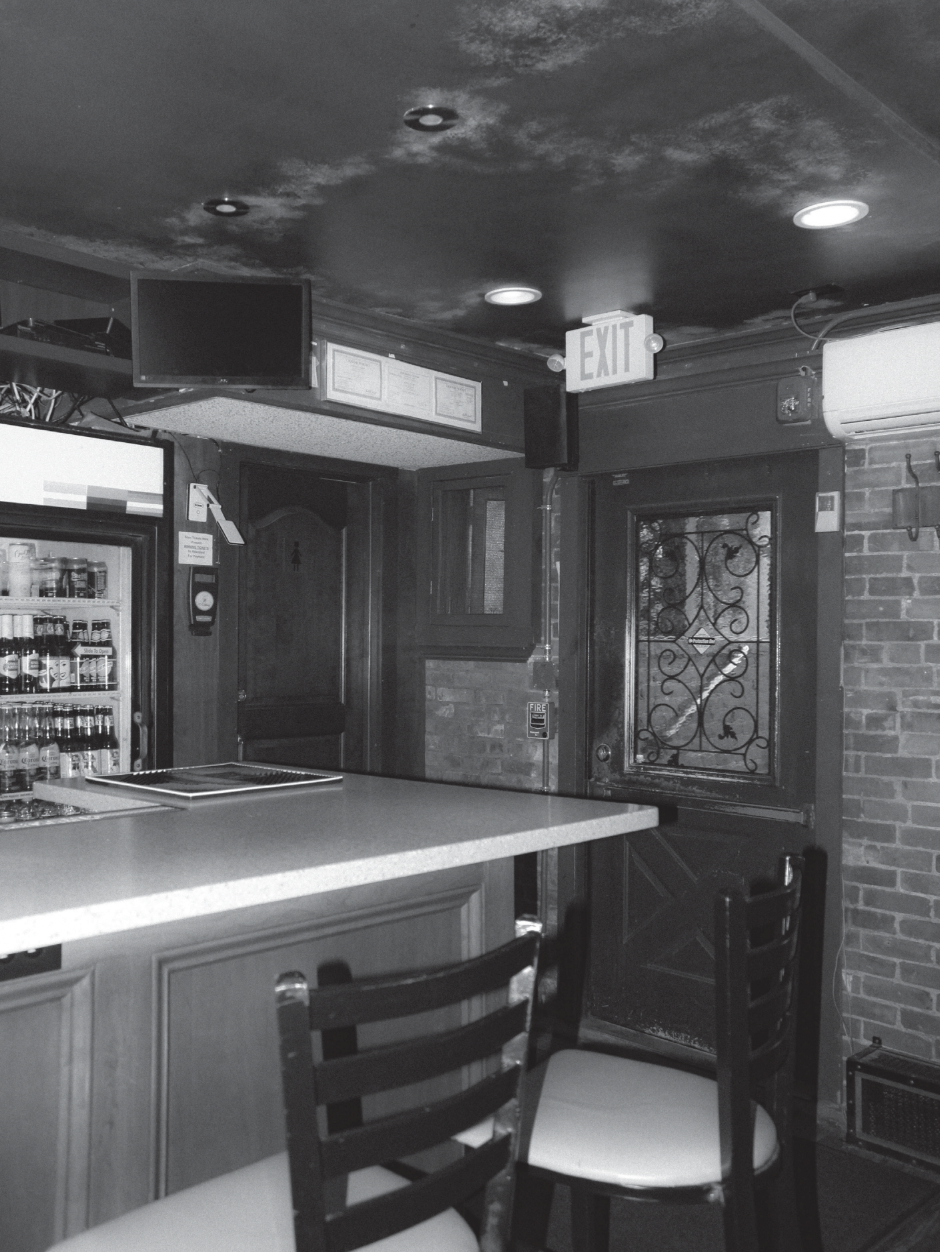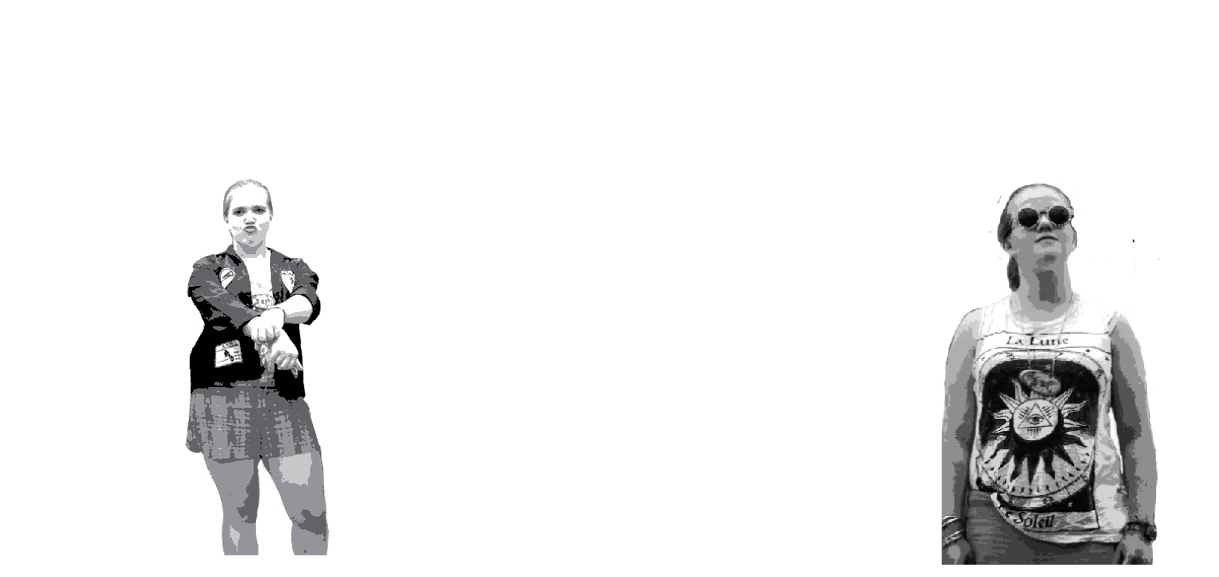It is a building that looks like it is hiding. Some windows are blurred with frosted glass. Others are boarded up. The walls are painted an aged white, peeling at some parts. On the side of the building, a small, orange sign names the building: Partners. Underneath a piercing streetlight, just next to the mural of a smiling Anne Frank, a man stands by himself, a lit cigarette in his mouth. Nothing on the outside reveals that the building is one of the oldest gay bars in New Haven.
On Fridays and Saturdays, Partners opens its second floor to reveal a glittery night club. There, mirrors cover the walls and a spinning light shines on young, dancing bodies in the dark. Those are the endless nights—loud and hazy and crowded. On Sundays, the second floor closes, leaving the ground floor open for karaoke night. It draws in a smaller crowd. Now, it’s Monday night in February and the bar is barren—except for Paul, me, and two drunk men. The two men had waited outside the bar’s front door before he’d arrived. Now, they sit at the counter with me, babbling over each other. They interrupt Paul while he talks to me, asking for another drink. Paul leaves to fill up their shot glasses.
“I was telling him how annoying it is when people showed up to the bar at seven fifty-nine, knocking on the door,” Paul says, nodding towards me.
They cackle in response.
“If your ass is open at eight, you better be open,” one of them shoots back.
Paul half-smiles. Then, he turns to me and rolls his eyes.
I like Paul for two reasons. The first is that he speaks to me like a friend. By nature, I am an anxious person. Despite this, we quickly chat like two old gossips. The second is that he is seasoned. He moved to New Haven from Massachusetts over a decade ago to work at Partners. This is his eleventh year behind the counter, and it shows—he is fluid, quick with his words. He’s seen more than me.
“So what was the gay bar scene like when you first started working here?” I ask.
“I want to say it was more gay men. Today, we have everything. Like, sometimes I’m working and I’m like, when did this become a straight bar?” he says, pouring another drink for one of the men. “There’s a lot of different types of people that come in and out of here all the time.”
As he talks, these broad terms—“everything,” “different types of people”—become clearer. Paul tells me that Partners defines itself as a gay bar, a gathering ground that has historically served queer people in New Haven. However, the events that the bar hosts—karaoke open-mics, bingo nights, goth dances, drag shows—now draw in straight people alongside the typically queer crowd. It isn’t abnormal to run into straight couples on a Friday night. Partners’ clientele widened over the years; the bar became a space for a broader, open-minded community, rather than a specific queer one. Though these capacities still have queer communities in mind, the formerly rigid boundaries have blurred.
“So the culture of the clientele has changed?” I ask.
“Yeah, absolutely. I mean, it doesn’t ruin the vibes or anything. It’s just that times are changing. Gay bars, straight bars, you’re going anywhere you want,” Paul says. “No one’s really afraid to come here anymore. I mean, ten years ago, the straight men, they’d be like, ‘Oh, my God, I’m not going to a gay bar.’”
I understand. The culture change Paul talks about is something that has manifested in my generation, my lifetime. I was twelve when the Supreme Court recognized gay marriage as a legal right. I watched characters on television proclaim their gayness to accepting arms. I had openly queer friends who I fought and reconciled and grew up with. Whenever I hated myself, I could look at my queer friends and recognize that they were lovable. And through my love for them, I knew I was lovable too. In an odd way, I recognize that my ability to do this is evidence of an undeniable societal shift. Could this shift change landscapes of queer gathering? What happens to a space when the stigmatization that used to define it is dissolving? I think these questions as Paul talks.
“Then, does this mean gay bars are not needed anymore?” I ask. “As opposed to, say, any old bar?”
“Well, we still need them. I mean, Partners? It’s always going to be Partners. Everyone’s going to be coming here,” he says, assuredly. “It’s just now, it’s like a space for almost everybody.”
“So what does Partners mean to you?” I ask.
“A paycheck,” Paul jokes. The two drunk men next to me laugh.
***
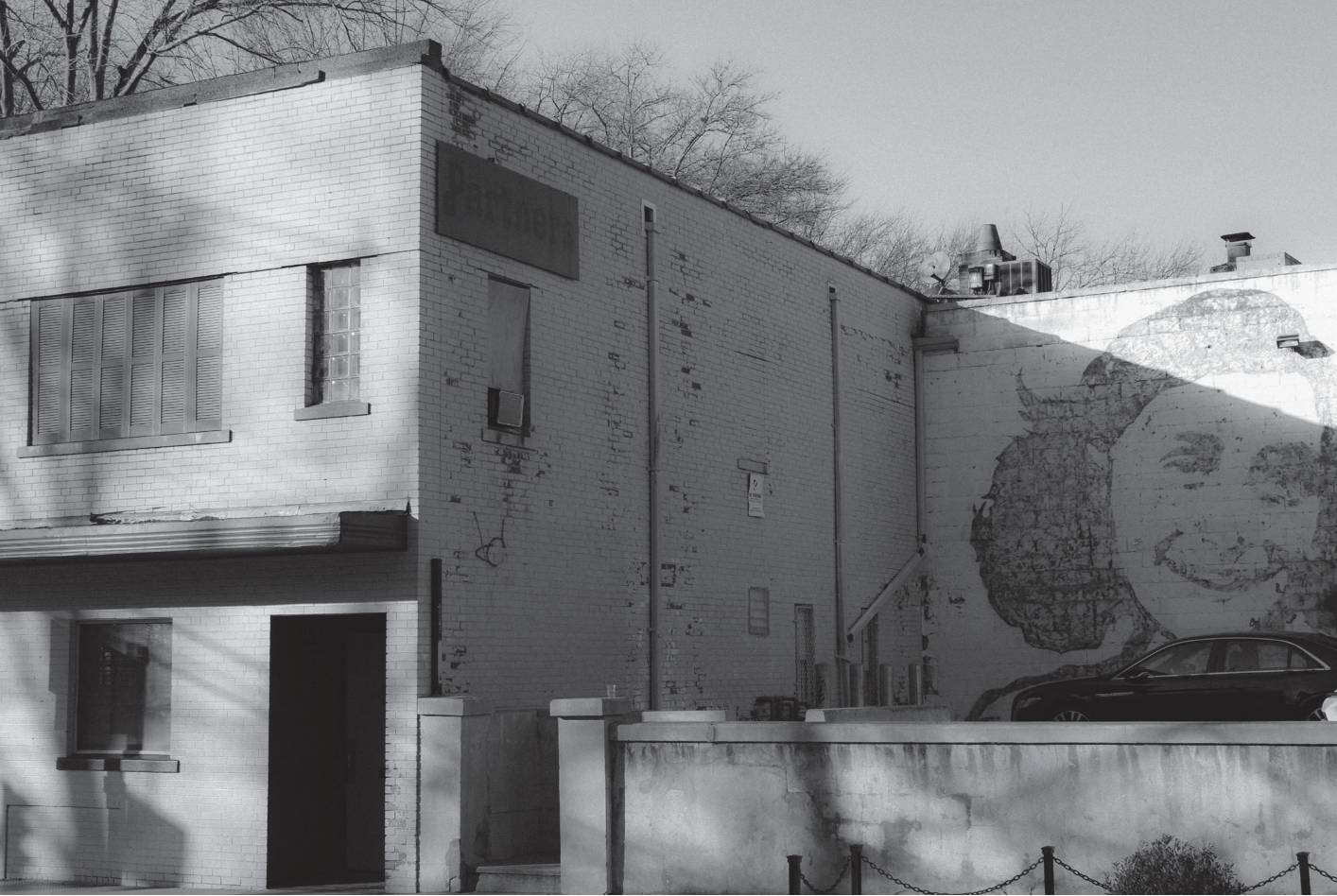
I meet Bernard at Partners, two hours before opening. I have never seen the bar so empty and quiet. The main room is dark except for two spotlights that shine overhead. We sit in adjacent seats by the counter. I begin to fidget. When I look at Bernard’s hands, I notice that he, too, is fidgeting.
Bernard mentions growing up in a conservative family in a small town in Mexico. In 1993, Bernard immigrated to the United States. He was in his twenties and exploring New Haven gay bars. At Partners, he met Dave Klemens. Today, the two are married and run the bar together as co-owners. According to Bernard, not much has changed over the years in how they run their business. They have their cheap drinks, their drag shows, their busy weekends and softer weekends.
“The community has been evolving but we don’t exactly change with them, you know,” he says. “You can do everything on phones. But I mean, person-to-person is better. I don’t know how to explain it.” He pauses. Then—“That was the model the previous owners founded. And Dave kept doing the same thing. If it’s not broken, why fix it?”
Gay bars depend on the “person-to-person” model that Bernard emphasizes in a way that differs from any other bar. Usually, people go to bars to meet other people over a drink, to form a community, to relax and let loose. But the notion of a gay man letting loose is a radical act in this context. It means sexual identities could finally be actualized. It means camaraderie in a society that has condemned queer lives. These often anonymous communities were essential to an entire generation of gay men; these bars were one of the few places they could gather. Outside the normative hours, into the nighttime, one could experience their first sexual encounters with other queer people in the liminality of the gay bar. With little barriers to self-expression, the gay bar becomes a place of genesis. Unique queer aesthetics were born: leather and kink sub-cultures, drag personas, cruising codes, creations a heteronormative society might find abnormal. Bernard puts it in a simpler way.
“For me, it was just liberating to come to a gay bar. I knew I was gay, always. But it wasn’t talked about until I came here.” he says. “You see your gay friends. It’s gay community so it’s fun, you know?”
Bernard tells me that Partners was founded in 1974 by Jack Garity and two friends, who ran the bar for fifteen years before handing it off to Dave. Almost fifty years later, the bar is still open. It had survived the peak of the AIDS epidemic and the twenty-first century decline of gay bars nationwide. In March 2020, the bar closed due to the coronavirus pandemic. The face-to-face intimacy that the bar provided for the queer community momentarily disappeared. Nevertheless, once Bernard and Dave got state approval, they opened their doors again in May 2021. People flooded the bar and lined up out the door, clamoring to get inside and dance. In a time in which businesses were closing left and right, the community showed out for Partners.
Perhaps Partners is one of the lucky ones. The years between 2007 and 2019 saw a closure of 37 percent of gay bars across the United States and the pandemic ensured the closure of even more. More dire, around 200 lesbian bars have closed since the 1980s, leaving twenty-seven lesbian bars in the nation today. There have been numerous theories to explain this sudden uptick in closures. Some blame dating apps like Grindr or Scruff that have replaced the gay bar’s person-to-person model. Some blame an exhaustion among gay consumers, resulting from the extensive marketing of spaces and products as “gay” or “queer.” But others seem to hint toward a changing of attitudes within the LGBTQ+ community. Namely, that with a new generation marked by queer acceptance, the need for specific gay spaces as safe spaces is diminishing. In the context of the gay bar, acceptance almost seems like a contradictory phenomenon.
Could this shift change landscapes of queer gathering? What happens to a space when the stigmatization that used to define it is dissolving?
“There will always be the same need for gay people: love and acceptance,” Bernard tells me. “And we’ll provide that here. Because you can make a fool of yourself here. You can go to another place that accepts gay people but you need a safe space. You know that you are different and you always need a place to see your friends.”
He holds his hands up: “This is it.”
In my head, I repeat love and acceptance. I decide to take him for his word.
***
In between interviews, I stop by the New Haven Pride Center. Inside, I meet Juancarlos Soto, the interim director of the center. When I enter, he has just gotten off the phone. After we talk, we find out both of our fathers are pastors. I laugh at this coincidence. We sit in a room covered with rainbow flags. On the wall beside us, there is a mural of men dancing. Queer history books line the bookshelf next to him. The room is warmly lit by a lamp, illuminating his face. We’re sitting in a chapel of queer paraphernalia.
“I think sometimes we can create harm when we call something a safe space, because the reality is violence still happens, even within our own community. I still interact with queer spaces that don’t feel safe,” Juancarlos says. “Unfortunately, the same things we were fighting fifty years ago are still the same things we’re fighting today. In terms of how anti-trans folks are describing trans individuals and non-binary folks, it’s really the same playbook that we were using in the eighties. It’s just we swapped around terms.”
When Juancarlos describes “safe” queer spaces, such as the Pride Center or New Haven’s gay bars, he likes to call them “brave” spaces. It is an acknowledgement—though aspects of safety have arrived with acceptance, in Juancarlos’ eyes, acceptance has not fully arrived. And if safety cannot truly be guaranteed, why offer a false promise? Any queer space demands the bravery of queer people to exist.
It feels strange to assume acceptance has arrived. Less than halfway through 2023, the United States has seen more anti-LGBTQ+ bills than the past five years combined. These bills have included a wide range of attacks, from bans on gender-affirming care and drag shows to the discontinuation of LGBTQ+ education in schools. Last year saw the murders of at least thirty-eight transgender people in the United States according to the Human Rights Campaign. And memories of Colorado Springs, where a 2022 shooting at a gay club left five dead and seventeen wounded, are still fresh on the minds of many gay club-goers. Yet, though queer violence continues to persist, Juancarlos and I both agree that the queer community has changed dramatically.
“The ways the HIV epidemic and guilt have marked older generations compared to how its marked younger generations are very different, right? Because of how much more we know around prevention and how fewer deaths we have now in comparison, when you talk to younger generations, the way you talk about the virus is almost flippant in younger generations compared to older adults,” Juancarlos says. “I think all of those things create differences in their experiences and the issues that they face. But I think if we pause and talk to each other, we may realize that they’re more like the same things that we were fighting.”
He’s right. Scrolling through TikTok, I come across influencers like Zach Willmore, who has been vlogging his life since his positive HIV test results. The videos are mundane. In some, he powders his face with makeup while talking about his medication treatment. In others, he shops for shoes. The end result, even on an interface like TikTok, is revolutionary—HIV is no longer seen as a death sentence. But with this cultural shift, a strange dilemma arises: is normalization synonymous with forgetting? Juancarlos celebrates these generational changes. At the same time, he still seems concerned, unconvinced. We are still fighting the same things.
“The movement sort of went dormant and silent. We were like, ‘Oh, we have gay marriage. We have a president on TV talking about his evolution on same sex marriage. We don’t have to worry about high risk infections of HIV.’ Mind you. Black and brown, specifically, black trans women, were getting murdered at incredible rates,” he says. “Honestly, the LGBTQ+ community sort of got complacent. It feels like we are going backwards these days.”
***
A street over from Partners, another gay bar called 168 York Street Cafe hides in the basement of a brick townhouse. Its windows are shy, peeking just barely above ground level. From the outside, I don’t notice too much. Maybe the movement of a dim shadow. And a faint Whitney Houston melody. When the night falls, loneliness calls…
When I enter, I hear the disco of the seventies, the divas of the eighties—Whitney Houston, Cyndi Lauper, Donna Summer. It’s a far cry from the glitzy dance-pop that had reverberated from Partners’ speakers. Nobody here dances. There is no need to. 168 York is a pub, not a nightclub. Instead of movement, there is the warm clamor of voices. The handful of patrons all seem familiar with one another, sitting on the long counter, talking over each other, laughing. Once in a while, a man walks in and the noise crescendos. People look up, nod, hug, say hello, then goodbye. Amidst the noise, Joey Goodwin, the owner of the bar, sits at the very end of the counter, a seat usually reserved for him. I sit next to him.
It feels strange to assume acceptance has arrived. Less than halfway through 2023, the United States has seen more anti-LGBTQ+ bills than the past five years combined.
“Look at this handsome gentleman interviewing me,” Joey tells a leaving friend. “Oh, who am I kidding. You look old enough to be my grandson.”
I laugh. It’s true. I am the youngest in the room by many years. As I sit next to Joey, I realize I have never in my life been surrounded by older gay men. Age, I realize, is a strange privilege. For an older generation of gay men, lives seemed quickly lived. In a way, escaping youth was an odd accomplishment. Here, all these men sit laughing, in a future they have created for themselves. The wooden walls—a worn brown—testify to the bar’s age. The floor’s faded planks creak at certain steps. Joey used to sand the floors when he needed to deep clean. Now, after so many years, he can’t sand them down anymore without their nails breaking loose. Between the previous owners and Joey, 168 York has existed in some form for about sixty years, making it Partners’ senior. The bar, like Partners, has stood through the heights of the AIDS epidemic and COVID-19, as well as a fire that burned down its old location in 1978.
Joey talks about the levels of caution that used to exist for gay bars. He tells me bar-goers would park streets away from the bar and wear reflective jackets to obscure their identities as they entered and left. Anonymity was synonymous with nightlife.
“You had nicknames when you were going out, you know. People said ‘Call me Charlie, call me this, call me that,’ So everyone had names until you’re going back to the pub again and all of a sudden Charlie didn’t show up,” he says. “Then you found out that Charlie wasn’t his real name. And then you found out that if you didn’t see him in six months, you were sure he passed away.”
He quickly says goodbye to a departing friend. Turning back, he takes a sip of his drink.
“People who were different came to a gay bar because there was no place else to go. Gay bars were shelters for them,” Joey says. “You wouldn’t see too many straight people in the gay bar back then. They were homophobic. We lived underground purposely.”
Joey sees more straight people entering 168 York now. This isn’t anything that bothers him. In fact, he finds it humorous. He describes how a straight man will walk in, bypass the rainbow flags hanging above the drinks, the trans pride colors on the refrigerator, the drag show advertisements on the walls, and sit down for a drink. As more of the regulars walk in, the man will slowly realize where he is. Joey describes the man’s sudden nervousness when he asks the bartender if 168 York is a gay bar.
“I love it. It just entertains me the most. I’m saying to myself ‘God, I hope so-and-so doesn’t come in. They’re going to give the whole thing away!’” Joey says, laughing.
“Do you think the gay bar should in some way be gate-kept?” I ask. “As in just for gay people?”
Joey shakes his head. “No. I always wanted to be an educator. Being a bar owner, you have a responsibility to say this is unacceptable, this is acceptable.” he says. “I thought the only way that I would ever fulfill that dream was to have people come in here and let them know that we’re not as bad as they think.”
How Joey sees it, gay bars are used as a kind of guided discovery. By having straight people confront queerness in the gay bar, the fear regarding sexuality becomes obscured and ideally, leads to an obvious reckoning—that queer people, at their foundation, are human too. In the gay bar, the straight man becomes othered by his straightness. Sexuality is not defined by its relation to heterosexuality. It is defined, for once, in the context of queerness.
“Are people trying to start new gay bars these days?” I ask.
“I don’t see anyone waiting in line to open up a gay bar, that I can tell you,” he says. “They don’t want any more duplications of a gay bar anymore, because everything’s so diluted now. Most people don’t have to go to a gay bar anymore.”
“Do you think at one point…” I start to say.
He interrupts me, already knowing my question. “Your question is, okay. There was a need for a gay bar but because of cultural changes, you’re thinking how long I can stay in the game for.”
I nod. He looks back at me knowingly. In the background, there is an eruption of laughter. Someone, another friend of the bar, must have walked in.
“I question myself every day about that,” Joey says. “More and more people keep accepting the fact that there are different people. And because of that, our customer base is dropping. Now people are accepted. They can go anywhere they want right now, and have a really good time.”
As he says this, I look at his face. His voice does not change, nor does he look upset.
“Why do you think the bar has lasted as long as it has?” I ask. “Through so much?”
“We are resilient,” he says. His voice quiets. “But why? That’s the question.”
I pause when he says this. Joey had asked a question that I often think of: Why do we have to be resilient? Put another way, why does it cost so much strength to live?
***
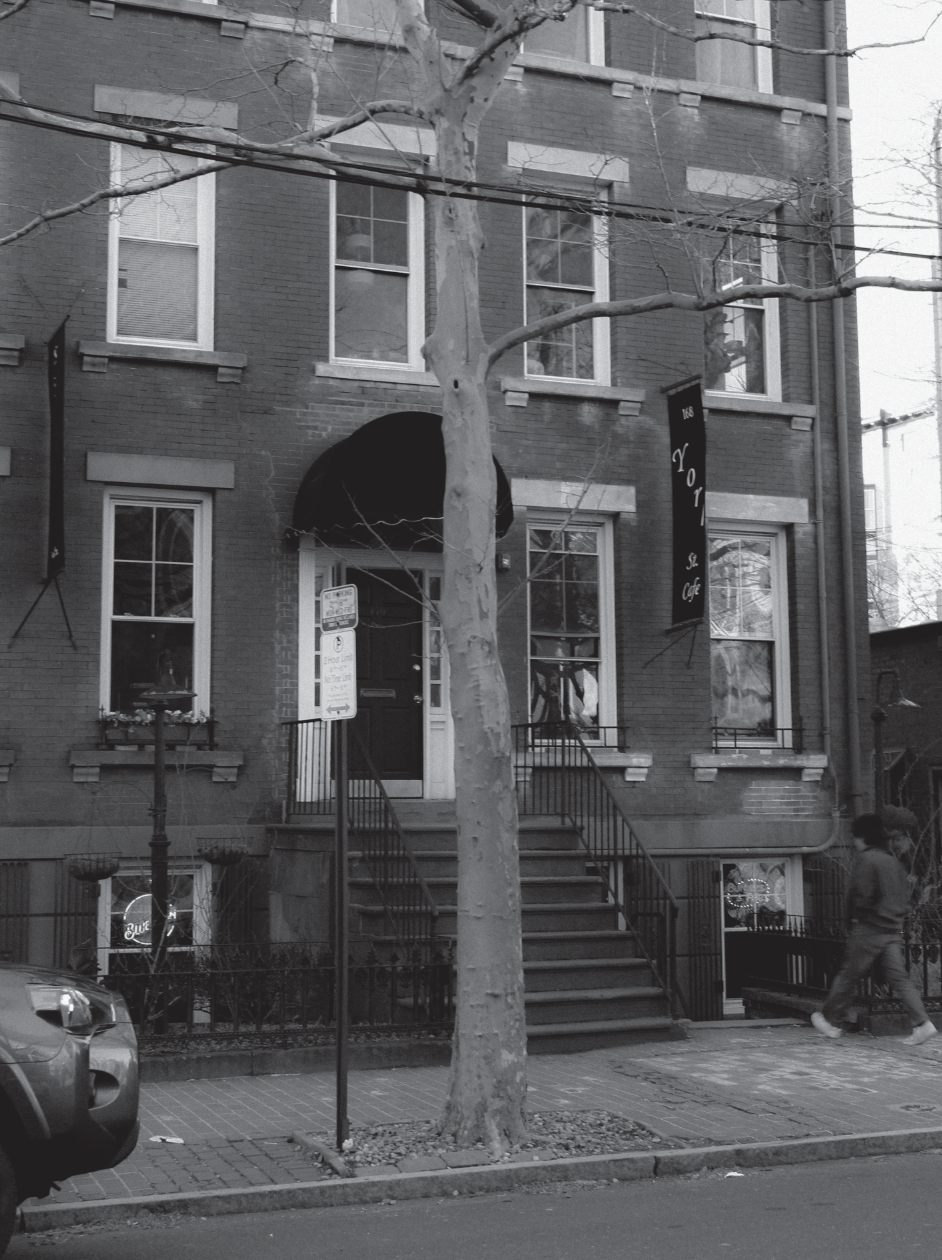
The next day, 168 York is empty. The noise that filled the bar the night before has slipped out the window. Behind the counter, a bartender shuffles a set of cards, then lines them facedown on the counter. He plays by himself. I do not bother him.
In the next room, I meet Seth Evans. He is just about to have his weekly dinner here at 168 York. He sits under a dim spotlight, sipping on a golden drink. It glows in the light. Seth was the last editor-in-chief of a Hartford-based LGBTQ+ publication called Metroline. The magazine intimately captured queer New England life from the AIDS epidemic to just after Connecticut’s legalization of gay marriage in 2008. Between their coverage of the epidemic and interviews with activists, the magazine advertised the Connecticut bar scene. Seth knows many of the bars closely, especially 168 York, where he would write many of his own articles for Metroline at the counter.
“What does the gay bar mean to you?” I ask.
“The bar scene means to me what it means to the first person that walked into the oldest gay bar in Connecticut,” Seth says. “Sanctuary.”
“Sanctuary,” I repeat back to him.
“The normal kid grows up in a home environment where they’re seeing Mom and Dad, and all the normal heterosexual way things are supposed to be. Where does that kid get guidance?” Seth said. “If you don’t come out to the clubs and allow yourself to be yourself, you’ll never know who you are.”
In the gay bar, the straight man becomes othered by his straightness. Sexuality is not defined by its relation to heterosexuality. It is defined, for once, in the context of queerness.
This form of sanctuary is well-encapsulated in the pages of Metroline. Near the beginning of most issues, there are pictures of New Haven gay bars at their prime. A camera’s flash reveals wide smiles, sparkling drinks, bare skin. The dark rooms are filled to the brim with bodies. Queer joy is abundant. Underneath, captions read their locations: Chapel Pub Cafe, Choices, Maxie’s, Saloon—all older New Haven bars. Large bar advertisements adorn almost every other page. The back of each Metroline edition reveals a list of clubs for each Connecticut city, all of which have advertised in the issue numerous times. The sentiment was clear—the clubs were open and alive.
“We started doing the magazine spreads of all the photos,” Seth says. “People would be very, very interested. They would go ‘Oh, I might be in it’ and they all started grabbing the magazine to look at it.”
As the years passed, though, Metroline began to falter. As more advertisers began using online mailing lists and other digital methods, Metroline, alongside other advertisement-reliant publications, took a hit. By the early 2010s, the magazine had become defunct.
“The internet started coming in. And that started killing the magazine,” Seth says. “The bar owners more and more started saying, ‘Why should I pay an ad in your magazine?’ It just became financially not feasible to keep the magazine in print because the bars weren’t paying.”
Over the years, the bars listed on Metroline’s backpages started cycling out, too. Seth says himself that the lifespan of a bar at the time was at most seven years. In New Haven, the gay bars—Choices, Maxie’s, Saloon—slowly became replaced with the Brownstone, the Krpyt, Beach Head Cafe. And after a few years, those new names disappeared from the pages of Metroline. The addresses still exist today, but in their places, new businesses now stand. In some cases, only empty, desolate buildings remain. At a certain point, the only gay pubs that stood were Partners and 168 York.
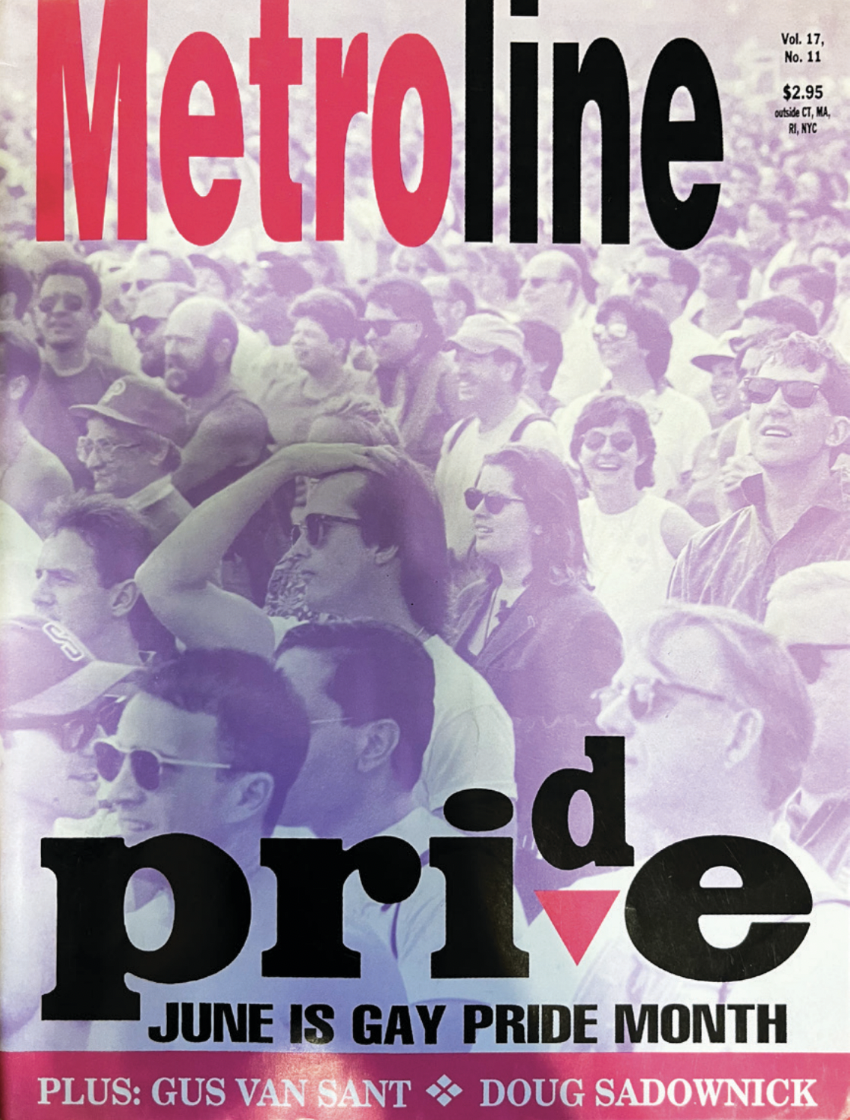
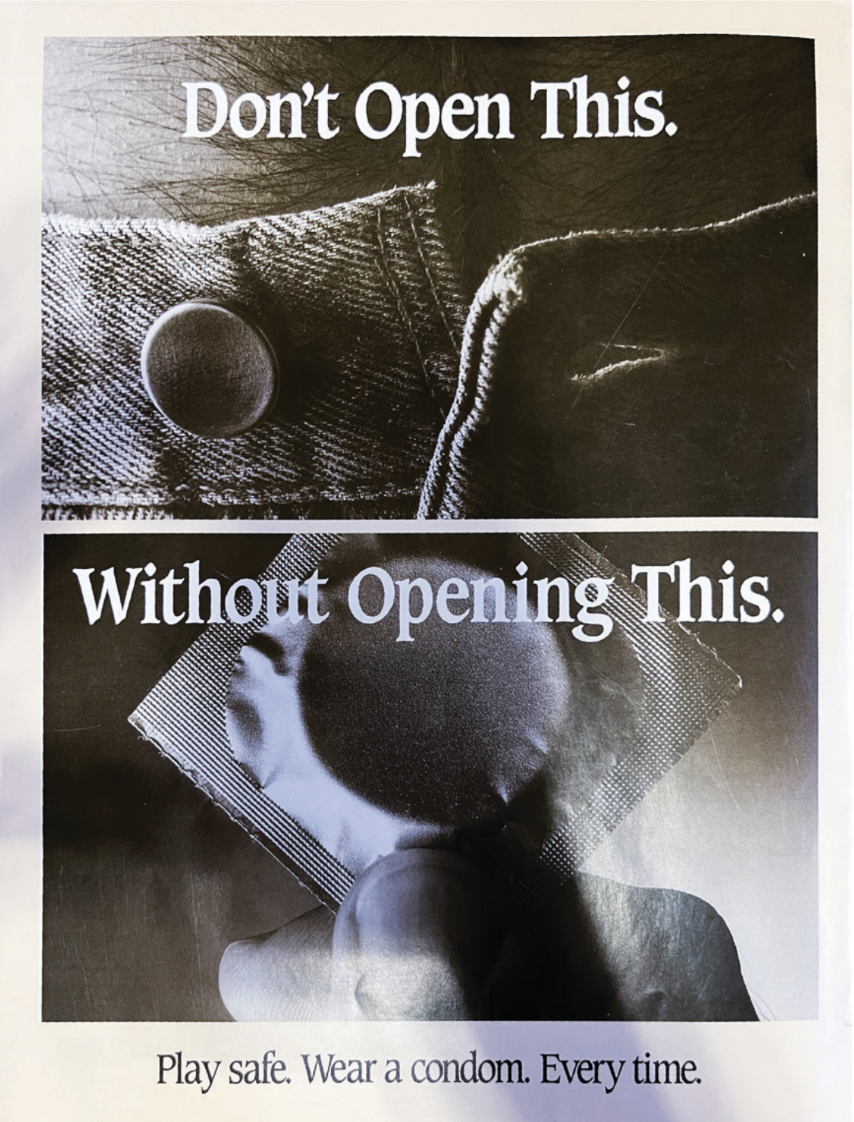
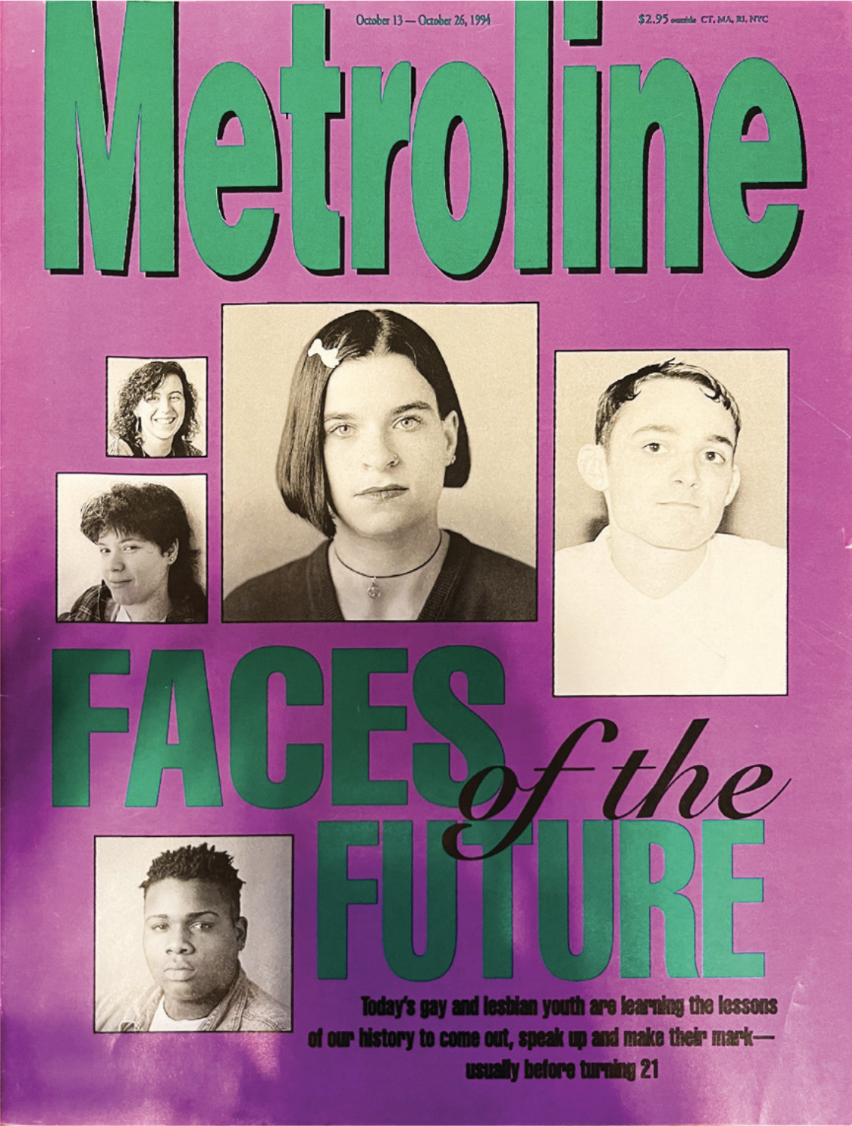
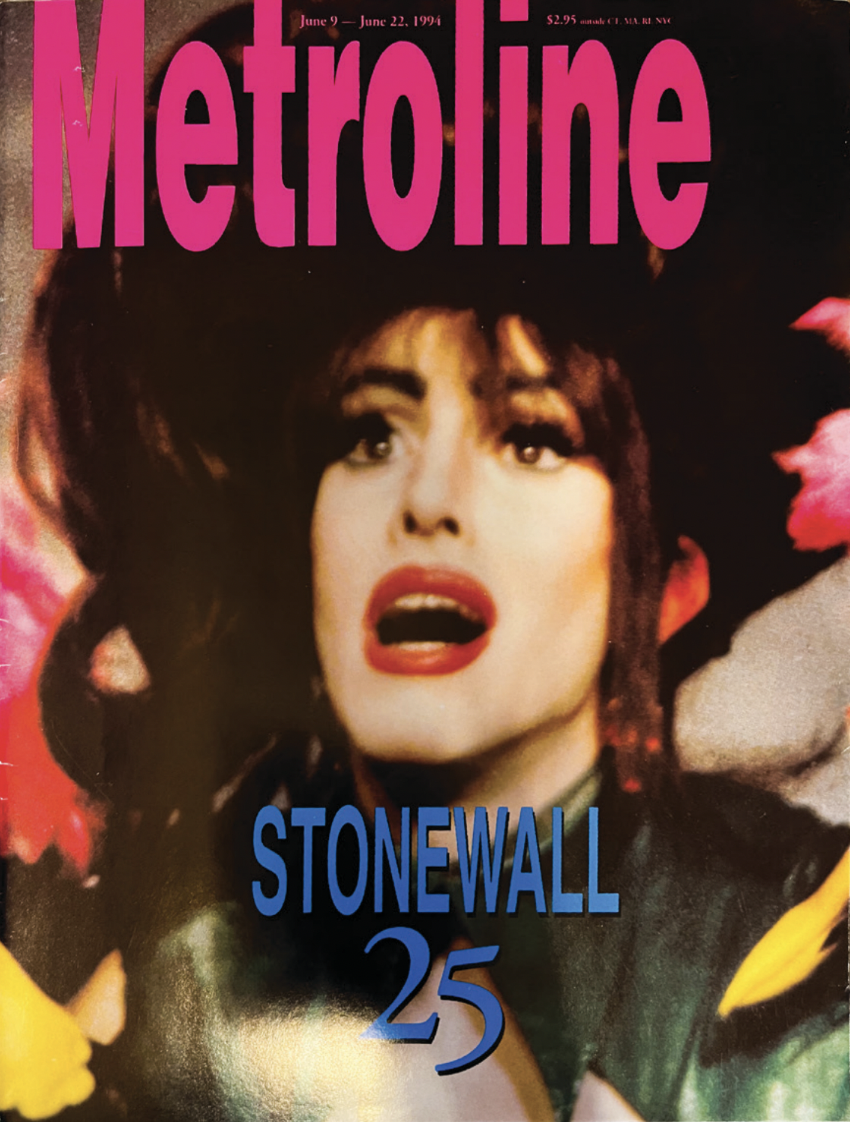
The front covers and one back cover of Metroline magazine. Photos courtesy of Jabez Choi.
“Will the bars continue to be a sanctuary?” I ask.
“It’s not as potent now as it was then. You’ll see straight couples come in and sit down and have drinks for a while. The acceptance, I don’t know if it’s a good way or a bad way, kind of diluted the population.” he said. “You found different people coming in, you know, it became like foreigners in our sanctuary.”
“Acceptance,” to Seth, marked a departure from a point that a previous generation lived through. But how do we make progress while remembering the past?
“Do you feel that your experiences pre-acceptance are valued by my generation?” I ask bluntly.
“They don’t know that they appreciate it yet,” he says. “Each of these generations contributed, you know, little bits of acceptance, little bits of acceptance, little bits of acceptance, it was a great wall built by one stone at a time.”
In a Metroline article titled “Remembering Stonewall,” a contributor writes, “Our present community needs to remember the event with clarity…The 25th anniversary of the Stonewall Riots is a suitable reminder to do the right thing.” Later in the article, the writer honors the Black, transgender and gender non-conforming activists who had been leading the queer liberation movements since the nineteen-sixties. In a later issue, the fear of a collective queer amnesia is spelled out in an op-ed titled: “WE MUST NEVER ACCEPT AIDS.” The contributing writer opines to the remaining gay community that an acceptance of AIDS would be “forgetting” an entire generation of “brothers” lost to the disease. One advertisement pages after reads in large, bold lettering—“You can get HOSPITALIZED. You can DIE.” The last word takes up most of the page.
At the same time, Metroline writers envisioned brighter futures. An op-ed in a 1994 issue by Larry Kirk titled “THE YEAR OF QUEER” reads: “It is through such actions that our movement will ultimately prevail, that the world will be made safer for a new generation of gay boys and girls. If this can happen in 1994, it will indeed be the Year of the Queer, no matter what else may, or may not occur.” The magazine attempted to immortalize turbulent and frustrating moments. But the pages are yellowed. They carry a faint scent of dust. The advertisements and pictures look inexplicably off-kilter, an estrangement only time can inflict.
Seth’s face changes, just slightly, after he sips his drink.
“What about the people that aren’t here?” He says, his voice eases. “They have got no clue of understanding, all the sacrifice and all the commitment to equality that went down to create this, to bring it to fruition.”
***
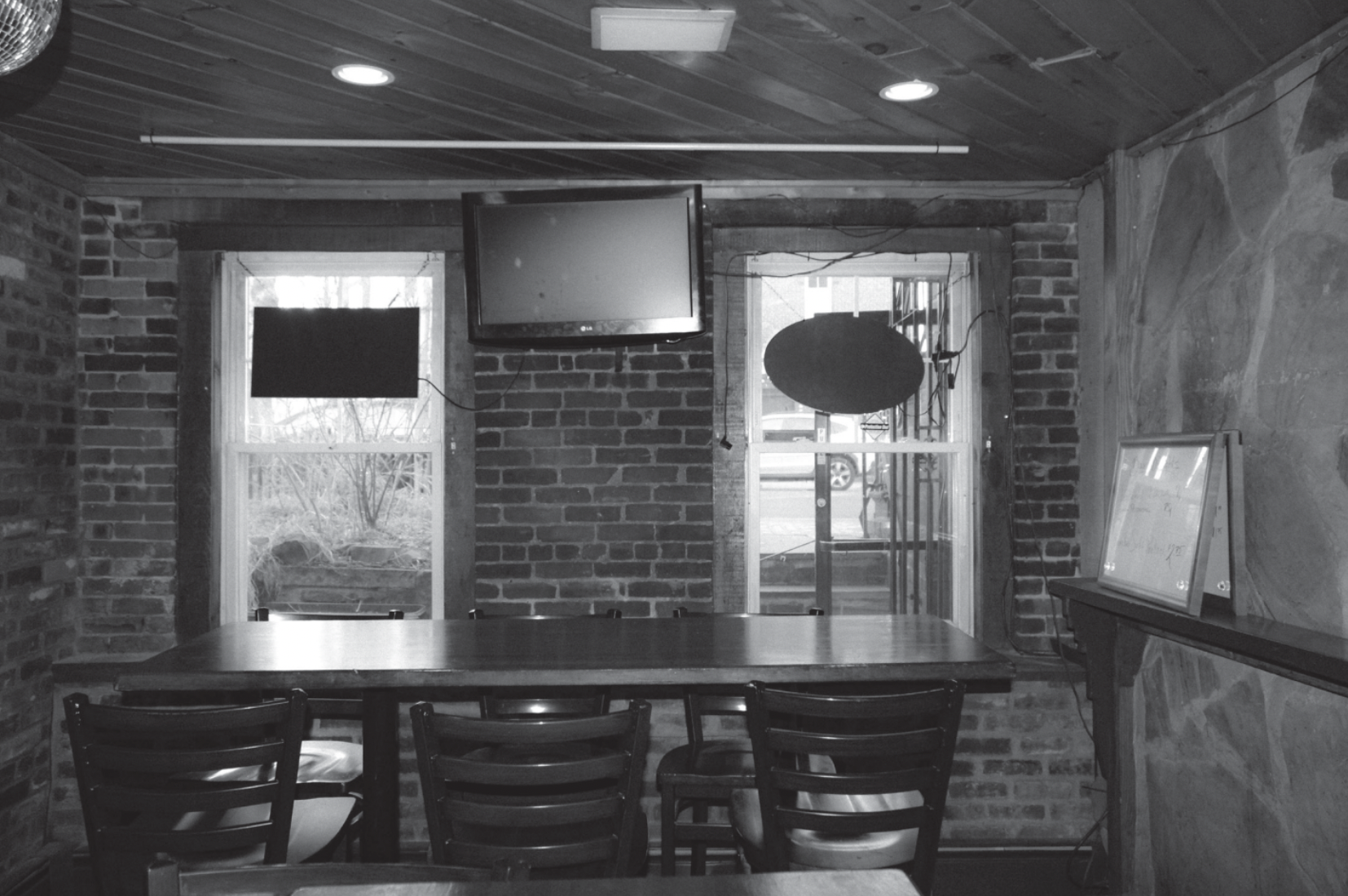
The next night, I talk with Bryan. He works behind the counter at 168 York some nights. He doesn’t like the title “bartender,” though. Making drinks is a gig he fell into by happenstance. A few years ago, Bryan walked into 168 York on a whim. He sat by himself at a table by the windows. Across the room, Joey played setback with some friends. Bryan watched, then eventually joined. They would play together every week for two years. One day, a bartender position opened, and Joey hired Bryan on the spot.
“He looked to me like, you’re gonna be my new bartender. I said ‘No, no. I’ve never done this before,’” Bryan says. Then, jokingly: “It just kept happening. I can’t get out of it. I can’t make it stop!”
Bryan says he is at a strange age, describing himself as being “right in the middle.” He didn’t live through the AIDS epidemic like the generation before him. But he says he wasn’t exactly marked by the “acceptance” that seems to define the current generation. He remembers growing up with stories of Matthew Shepard, a gay student at the University of Wyoming who was killed in 1998 as a result of an anti-gay hate crime. He still remembers when political parties across the spectrum all opposed gay marriage. Now, he notices the stark differences.
“I cannot just so unapologetically go to any bar I want to with a boy and feel comfortable kissing that person,” he says. “You feel comfortable kissing everyone until you do that in the wrong place. You don’t understand the importance of having a safe place. And why gay bars are so in need of being protected as safe spaces.”
As he talks, I notice that remembrance for Bryan is significant. He takes pride in remembering this past era. Certain traditions he still upholds with other bar-goers. Inside gay bars, Bryan calls his friends “Mary,” after a practice in the 80’s and 90’s of men calling their partners “Mary” to obscure the fact that they were seeing men. Inside the bar, Bryan only responds to feminine pronouns. Though this practice started off as a protection measure, Bryan reclaims it as a method of remembering queer culture.
“Why do we do that? I’m using these pronouns in a different capacity because that’s what historically what we built on, from the raiding of bars,” he says. “Was I a part of that? No, I wasn’t a part of that. Do I know a little bit of that history? Do I want to keep some of those things alive? Absolutely.”
“This is your way of remembrance,” I say.
“Absolutely. How do we move forward from that, while still acknowledging and respecting by maintaining our culture?” he says. “Are you looking at America? Like, where are we going right now? We’ve already done all this stuff and now we’re going back because we’ve forgotten what we’ve already done.”
When he finishes, Bryan leaves me to tend to a regular, a man in a checkered shirt. As he pours a drink for the man, he asks where the man’s partner is. Before he can answer, Bryan asks if they had been fighting again. The two laugh. Bryan introduces me to the man. I also ask where this man’s partner is. We continue to talk—about the man’s partner, about our own partners, our own histories. At that point, I stop taking notes. There is no need. I remember the night clearly. We had shared secrets and now, I can only write so much.
***
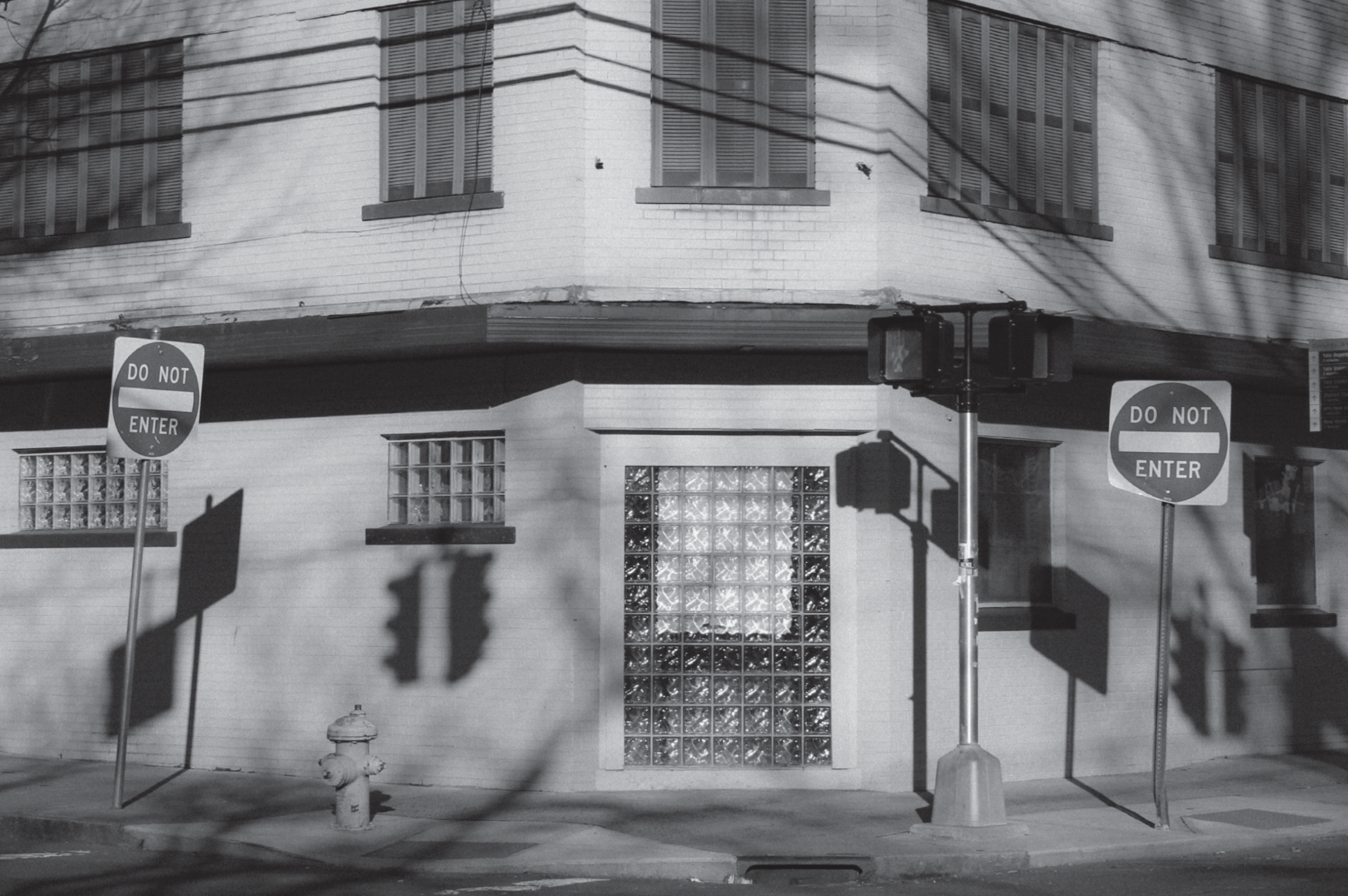
In a corner room at Partners, I play pool with a stranger who is old enough to be my father. I don’t call him my father, but I imagine that he is to feign some intimacy. It is a close game, only because we are both bad shots. In between turns, we talk. He is an artist from New York, but whenever he is in town, he stops by Partners for a drink. In the end, he beats me by just one ball. I’m lucky we haven’t bet on anything.
“You’re supposed to be better than me,” he says, laughing. “I’m all old now.”
He grabs his quarters and his bag. Before he leaves, though, I ask if I could see his art. He spreads his notepads across the pool table. They are worn. One by one, he shows me his drawings, each a sketch of a previous lover. Or a friend. Or a lover of a friend. They are all nude. He tells me how he fell in and out of love with one of the naked men. And as he talks, I realize the man misses him. Some of these men, he still visits back in New York. Others have since died. He doesn’t mention anything more. His eyes soften on the pages.
It’s karaoke night. In the background, a man sings “Bad Romance.” He’s impressively offkey. A group of people laugh. They all clink their glasses. I stay for a few more minutes, humming along to the Lady Gaga song. The man reaches the final chorus, and people begin clapping. I leave soon after. Walking down Crown Street, I shiver. It has suddenly become cold.
—Jabez Choi is a sophomore in Trumbull College and an Associate Editor of The New Journal.


